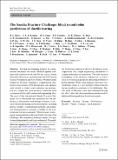The Sandia Fracture Challenge: blind round robin predictions of ductile tearing
Author(s)
Boyce, B. L; Kramer, S. L B; Fang, H. E; Cordova, T. E; Neilsen, M. K; Dion, K.; Kaczmarowski, A. K; Karasz, E.; Xue, L.; Gross, A. J; Ghahremaninezhad, A.; Ravi-Chandar, K.; Lin, S.-P.; Chi, S.-W.; Chen, J. S; Yreux, E.; Rüter, M.; Qian, D.; Zhou, Z.; Bhamare, S.; O’Connor, D. T; Tang, S.; Elkhodary, K. I; Zhao, J.; Hochhalter, J. D; Cerrone, A. R; Ingraffea, A. R; Wawrzynek, P. A; Carter, B. J; Emery, J. M; Veilleux, M. G; Yang, P.; Gan, Y.; Zhang, X.; Chen, Z.; Madenci, E.; Kilic, B.; Zhang, T.; Fang, E.; Liu, P.; Lua, J.; Nahshon, K.; Miraglia, M.; Cruce, J.; DeFrese, R.; Moyer, E. T; Brinckmann, S.; Quinkert, L.; Pack, Keun Hwan; Luo, Meng; Wierzbicki, Tomasz; ... Show more Show less
Download10704_2013_Article_9904.pdf (12.87Mb)
PUBLISHER_CC
Publisher with Creative Commons License
Creative Commons Attribution
Terms of use
Metadata
Show full item recordAbstract
Existing and emerging methods in computational mechanics are rarely validated against problems with an unknown outcome. For this reason, Sandia National Laboratories, in partnership with US National Science Foundation and Naval Surface Warfare Center Carderock Division, launched a computational challenge in mid-summer, 2012. Researchers and engineers were invited to predict crack initiation and propagation in a simple but novel geometry fabricated from a common off-the-shelf commercial engineering alloy. The goal of this international Sandia Fracture Challenge was to benchmark the capabilities for the prediction of deformation and damage evolution associated with ductile tearing in structural metals, including physics models, computational methods, and numerical implementations currently available in the computational fracture community. Thirteen teams participated, reporting blind predictions for the outcome of the Challenge. The simulations and experiments were performed independently and kept confidential. The methods for fracture prediction taken by the thirteen teams ranged from very simple engineering calculations to complicated multiscale simulations. The wide variation in modeling results showed a striking lack of consistency across research groups in addressing problems of ductile fracture. While some methods were more successful than others, it is clear that the problem of ductile fracture prediction continues to be challenging. Specific areas of deficiency have been identified through this effort. Also, the effort has underscored the need for additional blind prediction-based assessments.
Date issued
2014-01Department
Massachusetts Institute of Technology. Department of Mechanical EngineeringJournal
International Journal of Fracture
Publisher
Springer-Verlag
Citation
Boyce, B. L.; Kramer, S. L. B.; Fang, H. E. et al. “The Sandia Fracture Challenge: Blind Round Robin Predictions of Ductile Tearing.” International Journal of Fracture 186, no. 1–2 (January 2014): 5–68 © 2014 The Author(s) 2014
Version: Final published version
ISSN
0376-9429
1573-2673